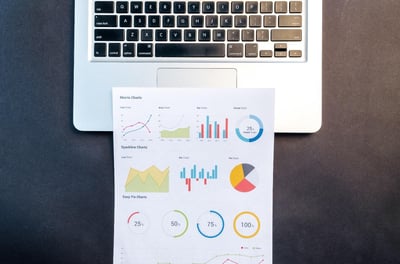
When it first came on the scene in the 1990s, software-as-a-service (SaaS) was a means to rationalize software purchases within a tight budget.
Businesses that couldn’t afford to own and maintain expensive on-premise software were now able to rent the same functionality – minus the burden of maintenance – from a cloud application.
Since then, SaaS businesses have scaled with evolving cloud tech into an entire industry of strategic business designers. Eighty percent of companies today use at least one SaaS application and continue to feed the momentum of its expansion into new streams like platform-as-a-service (PaaS) and infrastructure-as-a-service (IaaS).
To sustain its 500% growth in the last seven years and to justify its median 7.2X valuation multiple (for private SaaS) against its annual recurring revenue (ARR), the SaaS industry needs to keep the underlying spirit of innovation alive.
Having once disrupted the businesses engaged in software purchasing, SaaS platforms now have to discover and rediscover new ways to attract customers and transform how they think of capability enhancement.
This article discusses some of the most recent and noteworthy SaaS trends shaping the future of cloud technologies and their customers.
James Clear wasn't explicitly talking about SaaS companies when he made the distinction between goals and systems, but he could've been. The continued and systemic disruption that SaaS created outgrew its goal of transforming software buying and pricing. For want of a better opponent, it’s now disrupting itself.
SaaS business revenue is expected to reach somewhere around $716.52 billion by 2028, increasing at a compound annual growth rate (CAGR) of 27.5% since 2021. Like any expanding competitive market, customers have become spoiled with choices. Saas is contending with a new normal for pricing and undergoing a new value-to-cost realignment.
The rise of new SaaS platforms and more competitors are shifting the power balance from SaaS providers to SaaS buyers. Buyers in the SaaS market actively scout, compare, evaluate, and decide before they give vendors an active chance to influence their decisions.
Increased democratization of access to information, evaluation, and comparison now enables buyers to complete the buying process before even engaging a vendor. Growing new revenue strategies (tiered-subscriptions pricing or charging overages) to capture untapped value from prospects further indicates that pricing models play a significant role in SaaS buying decisions.
Without an upfront value-to-cost alignment, you might lose opportunities before you even make your first contact with a prospect. On the other hand, customer-oriented pricing directly influences sales volumes.
While tiered-subscription pricing broke down some barriers by allowing customers to choose packages depending on their needs, it still leaves room for apprehension because it forces them to commit to an expense over a contractual period – regardless of how much value they generate from the tool.
As a result, the SaaS industry is migrating to the more customized revenue model of usage-based pricing (UBP) to expand access to entry and bring better price-value alignment.
According to OpenView Partners, 45% of SaaS companies had some form of UBP in 2021, over 34% in 2020. An internal study from Chargebee expects the adoption rate among SaaS software merchants to grow to 56% by 2023.
While still an evolving revenue model, usage or value-based pricing removes unproductive customer expenses by directly tying the money spent to the value gained from using the product. Businesses can also use pricing as a growth lever and a sustainable customer acquisition strategy.
Value-based pricing is the second-most popular revenue model after seat-based pricing. Startups and larger SaaS companies, like Datadog and Twilio, have adopted usage-based pricing. Here are revenue growth and net dollar retention (NDR) rates for public usage-based SaaS.
Source: Insight Partners
By removing the cost of inertia – expense despite non-usage of a product – consumption-priced SaaS also minimizes the risk of customer exits, thereby sustaining relationships. Companies that employ UBP-oriented SaaS models typically exhibit higher net dollar retention rates of 120%, averaging roughly 10% higher than their traditional peers.
Despite the growing adoption of consumption pricing, tiered pricing remains ubiquitous in the SaaS market, thanks to its ability to bring predictable revenue.
SaaS startups and larger companies are now acclimating to a blended subscriptions + consumption pricing model to get the best of both worlds. Using this combination, customers can still select a subscription tier, but they don't have to level up when they exceed their preset limits. Instead, they can pay overages on the additional resource used.
The blended revenue model accounts for better customer experiences by making usage fluid even within subscription tiers. It helps SaaS companies make revenue predictable while allowing for monetizing seasonal and infrequent users.
Sundar Pichai called artificial intelligence (AI) more profound than the discovery of fire, which is, admittedly, a touch lofty but not entirely without reason.
Despite the initial concerns about shaky predictive algorithms, the AI market is growing steadily and carries a revenue expectation of approximately $733.7 billion revenue expectation by 2027. Over-the-top players, social media tools, chatbots, analytics software, and emerging tech are using AI and machine learning (ML) to simplify complex tasks and automate redundant work.
SaaS and AI share a symbiotic relationship. While their developments provide better customization and nuanced solutions, SaaS products also give AI and ML a larger, more focused group to identify, analyze, interact with, and learn from. Multiple businesses and their sensitive use cases provide AI with the data volume and complexity it needs to improve.
Data accumulated for predictive behavioral analysis now helps automate customer relationship management (CRM) enrichment, chatbot automation, personalization of customer interfaces, customer segmentation, and churn prediction.
Collecting anonymized revenue information and running it through an AI and ML module also helps subscription businesses predict cash flow and revenue pipeline. Most subscription metrics trackers deploy some form of AI or ML in their analytics dashboard to make success measurement more efficient.
The role of SaaS is to simplify business processes. It’s counterintuitive to assume that SaaS buyers will be content with prolonged implementation cycles or adjust to spending developer hours in integrations that further delay time-to-value.
It risks losing potential customers to more agile platforms, forcing SaaS businesses to reduce software deployment time. According to industry estimates, today's average deployment period is 7 hours, down significantly from 54 hours a decade ago, primarily driven by application programming interfaces (API) integrations.
MarketsandMarkets Research found that the API market, currently valued at $4.5 billion, continues to grow and influence SaaS buying and is expected to touch $13.7 billion by 2027 (at a CAGR of 25.1%).
Simple API calls can make new software easily integrable with an existing tech stack, but it also helps make their product roadmap more fluid and future SaaS buying decisions more flexible.
The shift to API-led SaaS has also resulted in developments in no-code functions, helping make contemporary front ends more efficient and reducing business operational turnaround time.
APIs began strictly to enable communication between one tool or system and the rest in the tech stack. However, it now finds a growing number of applications within the SaaS ecosystem.
APIs play a growing role in governing data access, contextual searching, and filtering for marketplace applications, as variables to track usage in consumption billing models, and as a security layer by de-linking software or applications from third-party servers (instead of having them connect to the API layer).
As the world oscillates between inflationary pressures and recession fears, customers want to cut down on discretionary spending. Businesses are simultaneously beginning to attempt to minimize overheads – a decision that suddenly tempers the adrenaline rush SaaS found soon after the start of the COVID-19 pandemic.
With capital becoming costly and scarce, SaaS businesses are more cost-conscious. Most of them are shifting their focus on strengthening existing relationships, retaining customers, and growing their lifetime value (LTV) through upsells as a means to bolster revenue. Industry benchmarks indicate that retaining customers is at least five times less expensive than acquiring new ones.
According to Bain & Co, a 5% improvement in retention can also generate up to a 95% improvement in overall revenue. The focus right now is on keeping existing customers rather than acquiring new customers.
Traditionally, retention strategies in SaaS mostly revolved around static discounted prices. While this helped deflect a few customers, there was no way to guarantee that the customer wouldn't cancel when the benefits (an extra free month, a 25% discount for the next year, etc.) expire.
To future-proof against customer churn, SaaS needs to identify the true value of customer retention. This entails understanding which customers are worth saving and further segmenting them based on their usage patterns and details.
By merging artificial intelligence with SaaS analytics, an entire industry now operates solely to provide SaaS businesses advance capabilities, such as:
All this now helps SaaS businesses build a retention ecosystem that can contextualize retention for canceling customers, invoke CRMs, and use email management to initiate customer win-back cycles and exhibit better value.
The SaaS industry is built on the free market and multitenant principles. For example, using Salesforce doesn’t limit businesses from using HubSpot or Zoho. Without the typical limiters on competing tools, the possibility of building a monopolistic environment is limited.
However, to increase their net serviceable market, players are also competing with each other on additional feature development. Instead of building them from scratch, this means acquiring smaller SaaS businesses to absorb additional capabilities and grow market share.
Acquisition and, correspondingly, feature evolution by more mature SaaS businesses often make way for full-funnel SaaS applications, or super apps, capable of serving an entire segment or function. In contrast, smaller SaaS businesses that are acquired utilize their new parent company's pool of resources to access a broader customer base.
For new players, money from venture capital is more challenging since they are in direct competition with more established players. At the same time, selling, general, and administrative costs (SGAs) continue to rise in established cloud-tech markets like CRM or sales enablement, limiting their ability to compete with enterprise SaaS.
Contrary to widespread optimism around SaaS margins, McKinsey analysis finds that barely a third of all SaaS companies achieve the Rule of 40, which states that the combined revenue growth rate and profit margin should be more than 40%. Fewer still manage to sustain it.
So smaller players need to continue investing in features, agility, and development to have a chance against the larger competitors. But that leaves little room for profitability. To survive, smaller players in these saturated SaaS markets view acquisitions as a means to exit and tap into their acquirers' large captive audience base.
For enterprise SaaS, the benefits of consolidation are two-pronged. Market consolidation is an effective way to better cost management. Still, mature SaaS companies acquire younger peers as a faster route to software development and feature expansion instead of building capabilities in-house. It not only helps them increase their net addressable market but also boosts ACVs through upselling.
The top quartile of SaaS companies with the most robust enterprise value or revenue generates revenue growth 3.5 times faster than the bottom quartile, making the valuation gap much more disproportionate over the years.
The result is a Kafka-esque transformation into a completely different beast – a new generation of cloud services that are essentially super-SaaS apps.
Zoom bought Five9, despite initial shareholder resistance, to expand into a $24 billion contact center market. Their acquisition is understandable because of pre-existing competitors like Cisco, Amazon's AWS, and Twilio's.
On the other hand, when Salesforce acquired Slack, it gained a much-needed communication layer on top of its customer interaction stack. At the same time, Slack found more strength in competing against Microsoft Teams.
This consolidation is also moving upmarket, partly because of rising SaaS valuations over the years and because enterprise SaaS software solutions are hitting the ceiling in revenue opportunities in some established markets.
Larger players in the SaaS industry are acquiring smaller businesses as a means to expand their capabilities, thereby increasing SaaS acquisition costs over the years. Valuation increases are also emblematic of the fact that the SaaS industry itself is growing at breakneck speed.
Source: Index by TNW
As the pandemic drove most industries up and over the digital adoption wall, new-age SaaS businesses found proof of concept in building products or solutions for niche verticals or industries.
Instead of adding value to specific business functions like sales and marketing, they solved particular pain points in specific markets like healthcare, automotive, and publishing.
The number of existing vertical SaaS companies grew by at least 28% between 2020 and 2021 and is likely to continue expanding. The success of Toast, Procore, and Blend, along with rumors of an $18 billion ServiceTitan IPO for 2022, is further proof of the immense possibilities in the vertical SaaS business model.
Unlike traditional SaaS players, vertical SaaS is cashing in gains from being in less-than-mature markets. Since the availability of industry-specific cloud services is still low, venture capitalists are looking to ride the early growth wave than reap their gains in a more mature market.
The vertical SaaS industry is growing with increasing interest from investors and venture capitalists. Public vertical SaaS companies have continued to raise more money since 2020.
Source: fractal
In turn, the new influx of capital will lead to the rise of more niche players targeting unaddressed niche markets. Since they’re competing with fewer players, vertical SaaS has a personalization edge over horizontal SaaS, making customer relationships more engaging. It can call on these deep relationships to boost ACV through upsells or product upgrades, which will leave enough runway for growth in the coming years.
As long as there’s an emerging technology and an opportunity for value creation, the tendency for SaaS to transform markets will continue – either through market innovation or channel innovation that encourages a new mobile-first service delivery. It’s perhaps the inherent spirit of the industry: a resistance to inertia that usually comes with years of hypergrowth.
The growth of software security, APIs, and data management tools, among others, proves that just like the industrial revolution before it, SaaS will also give rise to new business and revenue models. It’s a self-fulfilling cycle where innovation laterally expands to support the industry's hunger for process disruption. History truly has a repetitive charm.
Love trends? Get insight into what's happening in your industry with your buyers using the brand new G2 Market Intelligence.
Arijit Bose is a content strategist with nearly a decade of SaaS experience specializing in GTM and revenue growth. He has bylines in Reuters and G2 and has shaped narratives at Clazar and Chargebee, among others. In 2022, he won SaaS Brief's MVP award and has authored books on pricing and cloud growth.
Long-lasting customer relationships are vital to growing any business.
 by Nupura Ughade
by Nupura Ughade
In today’s competitive landscape, acquiring new customers is the table stakes.
 by Aazar Ali Shad
by Aazar Ali Shad
If you’re like most SaaS companies, there are probably 20+ companies in your category that are
 by Yasmine de Aranda
by Yasmine de Aranda
Long-lasting customer relationships are vital to growing any business.
 by Nupura Ughade
by Nupura Ughade
In today’s competitive landscape, acquiring new customers is the table stakes.
 by Aazar Ali Shad
by Aazar Ali Shad


